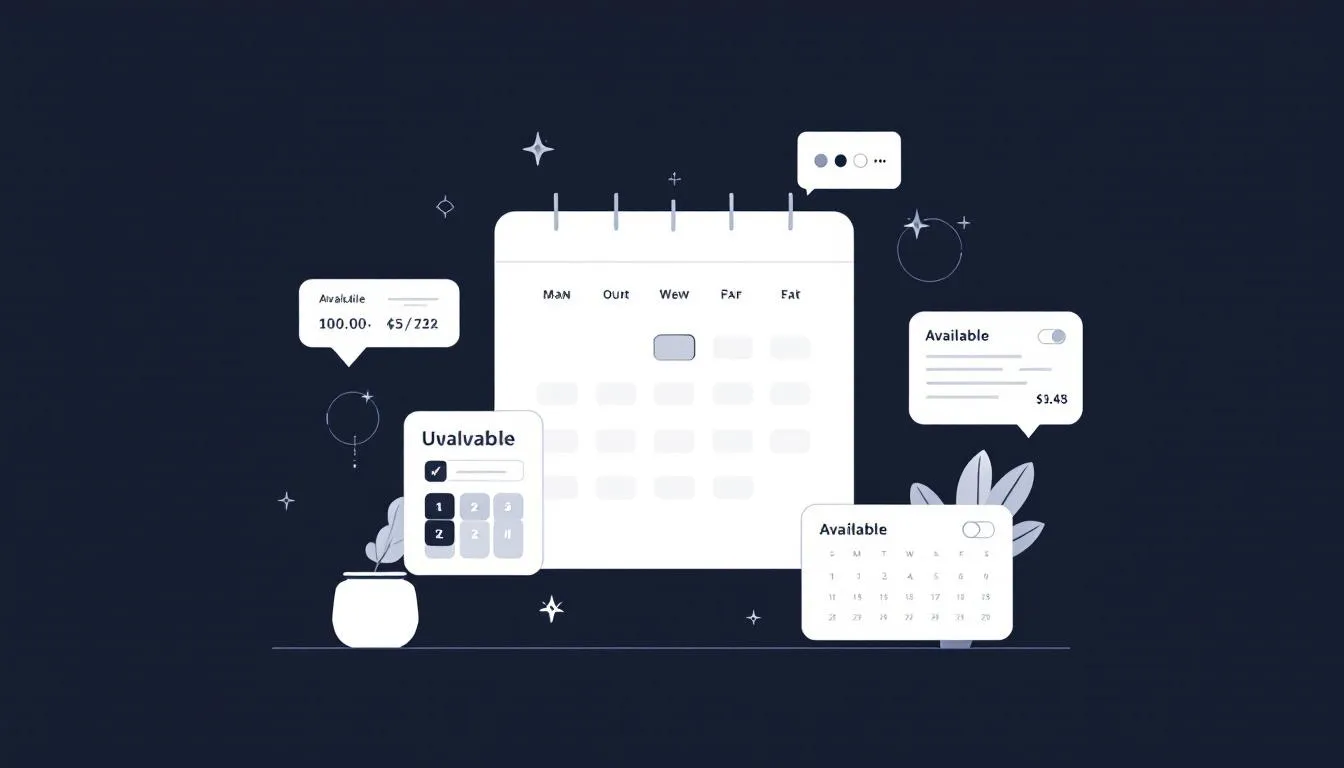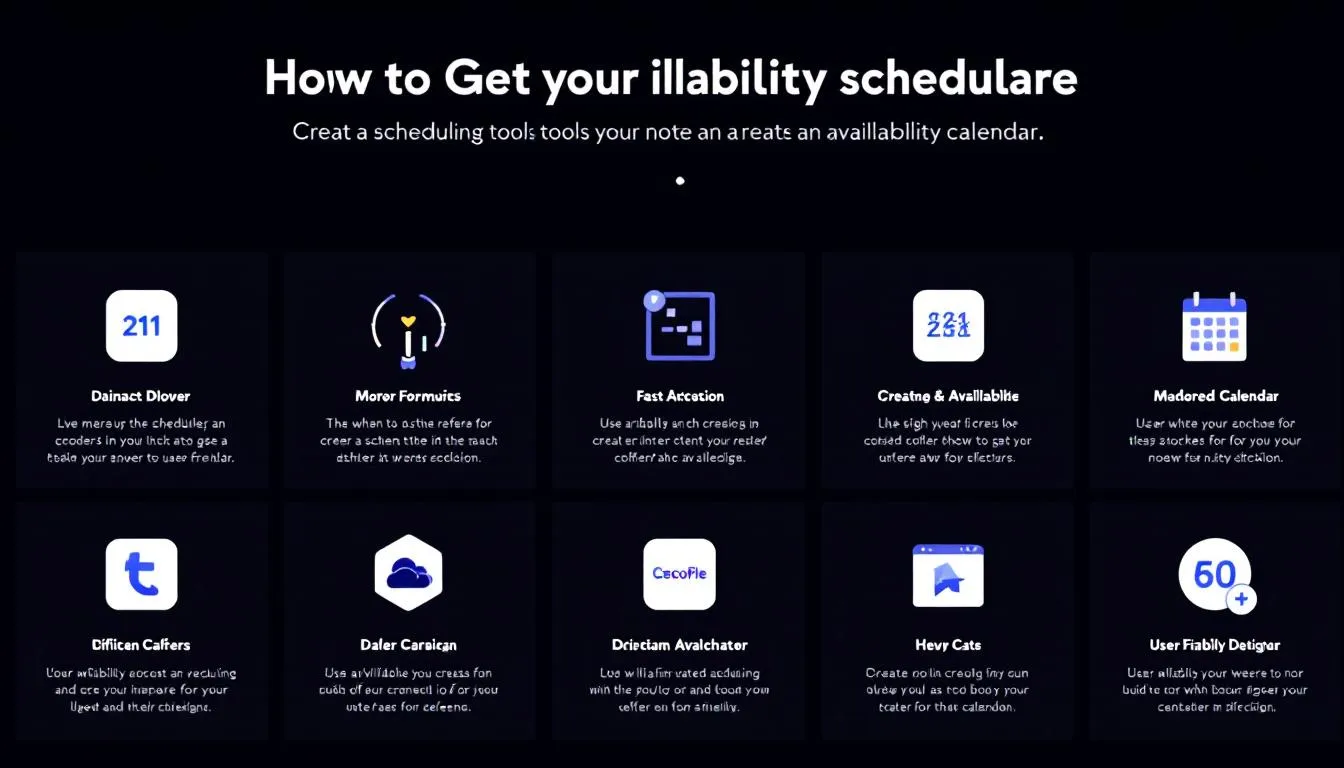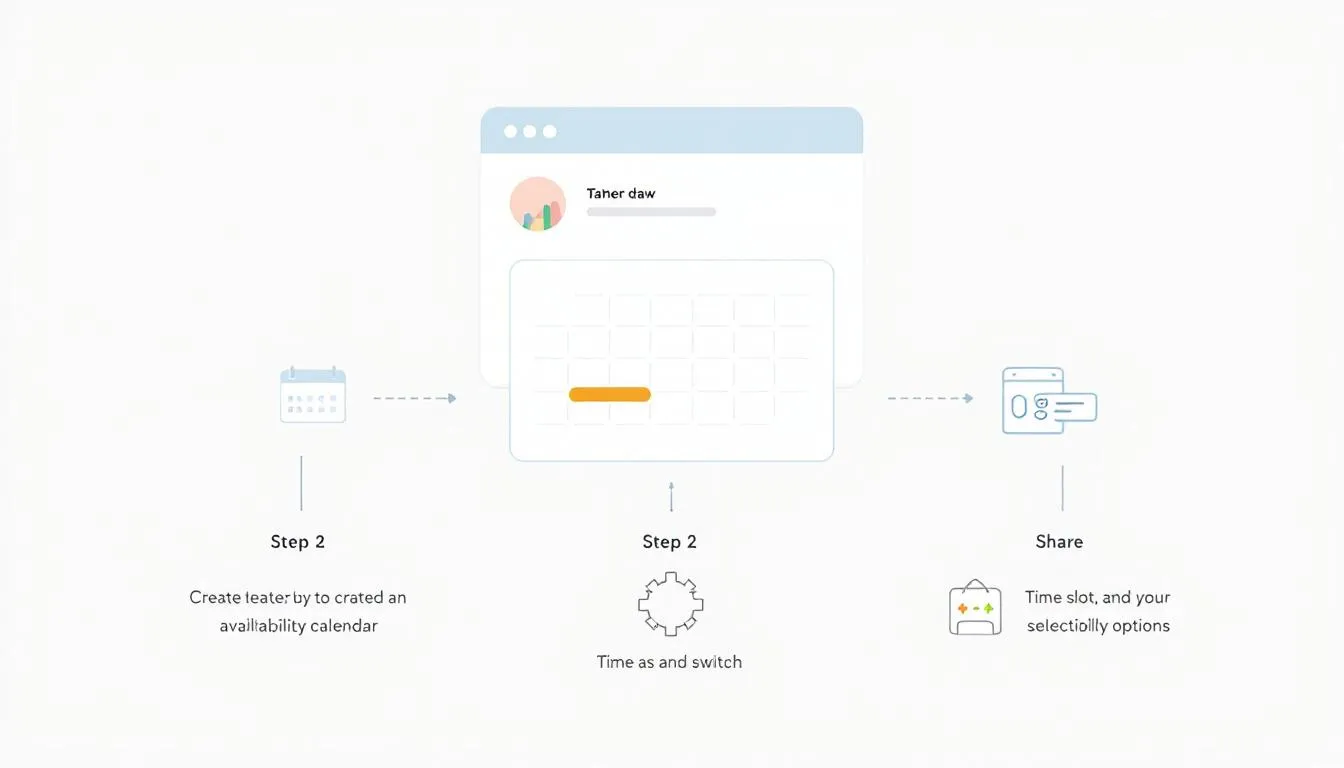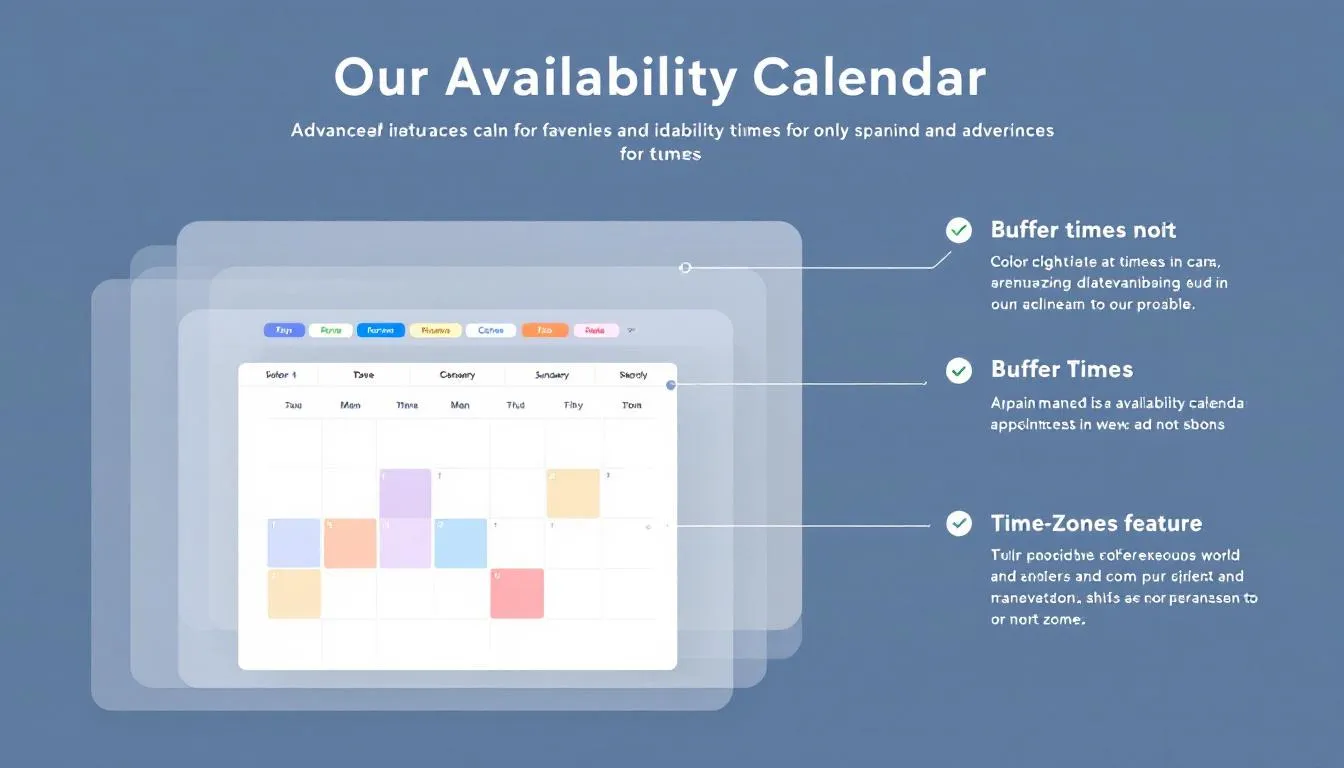Key Takeaways
- An availability calendar helps simplify appointment scheduling, avoid double bookings, and keep everyone informed about available time slots.
- Choosing the right tool, like Google Calendar or Calendly, is crucial to meet specific business needs and enhance productivity.
- Regularly updating and managing the calendar is essential for accuracy, which can improve customer experience and increase appointment bookings.
Understanding the Basics of an Availability Calendar

At its core, an availability calendar is a powerful tool designed to keep track of available time slots for appointments and bookings. Whether you’re managing a small business or coordinating a large team, an effective availability calendar creating can make scheduling as painless as possible, helping you avoid double-bookings and keep everyone on the same page.
Definition and Purpose
An availability calendar is a digital tool that visually represents booked dates and available times, making it an essential part of managing bookings, appointments, and resources. Every time slot should indicate who or what is involved in the booking, ensuring clear communication and minimizing confusion. This clarity is especially crucial for small businesses that need to allow customers to book appointments without overlapping schedules.
The primary function of an availability calendar is to streamline the scheduling process by providing clear booking statuses and allowing for one-click bookings. Essential elements include available dates and time slots, info on booked items, and intuitive booking statuses to prevent misunderstandings.
This makes it easier to manage employee shifts, meetings, and other commitments, ultimately reducing scheduling conflicts and helping to prevent conflicts, making your workflow smoother to stay organized and save time.
Key Benefits for Businesses
Availability calendars offer significant benefits for businesses, starting with improved coordination of people and resources through a shared calendar. This reduces confusion, minimizes back-and-forth communication, and clarifies available times, which is crucial for both employees and clients. By avoiding double bookings and keeping everyone informed, businesses can streamline workflows and enhance collaboration, leading to better productivity.
Using an availability calendar offers several benefits:
- Improves transparency and reduces scheduling conflicts, enhancing customer experience.
- Provides automation that leads to smoother bookings and clearer communication.
- Makes it easier for customers to book appointments and for businesses to manage them.
- Saves time and reduces human error.
- Ensures clients have a positive experience, encouraging repeat business.
Moreover, businesses that implement availability calendars can significantly reduce miscommunication, leading to higher customer satisfaction. The automation aspect not only saves time but also allows for more accurate scheduling, which helps in maintaining a professional and reliable image. In an age where customer experience is paramount, having an up-to-date availability calendar can be a game-changer for any business.
Choosing the Right Tool for Your Availability Calendar

Selecting the right tool for your availability calendar is crucial for effective booking management, tracking resources, and improving organizational efficiency. The initial step in creating your calendar is to choose a tool that aligns with your specific business requirements, as this will ensure that the calendar meets your needs and enhances overall productivity.
Popular Tools and Platforms
There are various scheduling tools available that can help streamline the appointment-setting process. Google Calendar and Calendly are among the most popular options due to their user-friendly interfaces and robust features. Google Calendar, in particular, is a common choice for managing appointments effectively, while Calendly is praised for its intuitive design, making it easy for individuals and teams to coordinate schedules.
For businesses with more specialized needs, GoodSolutions.tech offers customized scheduling solutions tailored to various industries. These specialized tools can provide a higher level of functionality and customization, ensuring that your availability calendar integrates seamlessly with your existing systems and workflows.
Factors to Consider
When choosing an availability calendar tool, several factors need to be considered to ensure it meets your business needs. Cost and budget constraints are critical, as different tools offer various features at different price points. Integration capabilities with other software can enhance functionality and ease of use, making it easier to manage your calendar alongside other business tools.
Customization options are also important, allowing you to customize the scheduling tool to fit your unique workflow and branding. By considering these factors, you can select a tool that not only prevents conflicts but also supports your overall business objectives, ensuring that your scheduling process is as efficient and effective as possible.
Setting Up Your Availability Calendar

Once you’ve chosen the right tool, the next step is to set up your availability calendar. This involves configuring the calendar to match your business’s specific needs, ensuring it functions effectively within your workflow.
Initial Setup
To start, choose a platform such as Google Calendar or another scheduling tool suitable for your business. When setting up your appointment schedule, include essential details like:
- The title
- Duration
- General availability
- Time zone
You can adjust your availability for specific dates, allowing for holidays or personal commitments. By defining available time slots for bookings, you ensure they fit within your set working hours, making it easier for a person to manage your schedule and avoid overbooking. Your ability to customize these parameters enhances your overall efficiency and control. Additionally, you can book time for specific tasks or meetings to further streamline your process.
Finally, setting up your calendar should also involve connect it to any necessary account and ensuring it is displayed correctly on your website or booking page. This setup phase is crucial for controlling how your availability is presented to clients and ensuring that all necessary information is readily accessible.
Customization Options
Customizing your availability calendar can significantly enhance its usability and visual organization. Utilizing color-coding and labels helps in distinguishing between different types of bookings and appointments. This makes the calendar more intuitive and easier to navigate, ensuring that users can quickly find the information they need.
Structuring the calendar logically, such as breaking down availability by day, week, or month, helps in organizing workflows effectively. Customization options should also include visual indicators that display important log details like names, services, or locations, which can further streamline the booking process.
Syncing and Integration
Syncing your availability calendar with your website and other platforms ensures real-time updates and accurate information for users. Embedding the calendar on your website is a straightforward process and crucial for providing clients with up-to-date availability at all times.
Integration with third-party conferencing services, like adding a conferencing link to an event, enhances the functionality of your availability calendar. This seamless connection ensures that all updates are automatically reflected, minimizing the risk of scheduling errors and improving overall efficiency.
Managing and Updating Your Availability Calendar

Once your availability calendar is set up, managing and updating it regularly is crucial to ensure it remains accurate and useful. This involves keeping real-time availability, handling cancellations and rescheduling efficiently, and automating notifications to keep everyone informed.
Real-Time Updates
Keeping your availability calendar up to date is essential for providing accurate information to users. Real-time updates ensure that any changes in availability are instantly reflected, preventing confusion for both business owners and clients. This is particularly important for avoiding double bookings and ensuring smooth scheduling.
Integrating your calendar with a scheduling tool allows for automatic calendar updates whenever your availability changes, minimizing the risk of errors. Platforms that support automatic updates help maintain optimal accuracy, ensuring that the most current information is always available to users.
Handling Cancellations and Rescheduling
Managing cancellations and rescheduling efficiently is a key aspect of maintaining an effective availability calendar. Adding blocked periods to indicate when resources are not available is crucial for managing cancellations. Utilizing tools like the Virto Shared Calendar App can enhance productivity by streamlining the booking process and minimizing the risk of double bookings.
Handling cancellations promptly and rescheduling appointments as needed ensures that your calendar remains accurate and up to date. This reduces scheduling conflicts and ensures that clients are always aware of the most current availability.
Automating Notifications and Reminders
Automating notifications and reminders is crucial for keeping clients and team members informed and engaged. Incorporating a feature to automatically notify clients of cancellations or rescheduled appointments can enhance communication and reduce confusion.
AI-powered chatbots can handle customer inquiries and facilitate appointment bookings 24/7, improving overall customer engagement. These chatbots can also send reminders and alerts about upcoming appointments, ensuring that clients are always aware of their schedules and phone calls.
Leveraging Advanced Features

Leveraging advanced features in availability calendars can significantly optimize scheduling processes. Incorporating AI capabilities and other advanced features can streamline operations and enhance overall effectiveness in managing appointments.
Buffer Times and Time Zones
Buffer times are essential for accommodating any overruns in meetings and providing a transition period to fill for clients and service providers. Many scheduling tools automatically detect and adjust times based on the user’s location, making it easier to manage appointments across different time zones and sync schedules.
Implementing AI scheduling for remote teams has proven to be effective in coordinating meetings across multiple time zones, ensuring fair access to all participants. This not only saves time but also ensures that schedules are managed efficiently.
Integrating with Video Conferencing Tools
Integrating your availability calendar with video conferencing tools is essential for smooth virtual meetings. Many scheduling applications now support direct integration with popular platforms like Zoom and Microsoft Teams, facilitating easy online meetings.
These integrations enhance the efficiency of scheduling and managing virtual meetings, making it easier to set up and conduct meetings without any hassle. Direct integrations with platforms like Google Meet ensure seamless virtual meeting setups.
Utilizing AI-Powered Chatbots
GoodSolutions.tech offers AI-powered chatbots that automate bookings, making the scheduling process efficient and user-friendly. These chatbots improve customer interactions by providing instant responses and personalized assistance, lowering the chances of customer frustration.
Implementing AI chatbots streamlines operations for businesses, allowing them to focus on more critical tasks as the chatbot handles routine inquiries. By automatically booking client meetings based on lead priority, these chatbots enhance engagement and conversion rates.
Lessons Learned
Businesses that have streamlined their scheduling processes reported a 30% reduction in double bookings and schedule conflicts. Companies that regularly update their availability calendars have seen increases in appointment bookings by up to 25%.
Utilizing integration tools with available calendar systems has allowed businesses to manage bookings across multiple platforms efficiently. Implementing real-time syncing with calendars ensures that businesses can provide accurate information to customers instantaneously, enhancing their overall experience.
Summary
In summary, creating and managing an availability calendar can transform the way you handle appointments, meetings, and resource allocations. From understanding its basic functions to choosing the right tool, setting it up, and leveraging advanced features, every step is crucial for maximizing efficiency and improving customer satisfaction. By integrating real-time updates, handling cancellations seamlessly, and utilizing AI-powered chatbots from GoodSolutions.tech, businesses can stay organized, reduce scheduling conflicts, and enhance overall productivity. Embrace the power of an availability calendar and watch your business thrive.
Frequently Asked Questions
What is an availability calendar?
An availability calendar is a handy tool for keeping track of open time slots for appointments and bookings, which helps you manage your schedule and prevent double bookings. It’s a must-have for staying organized!
Why should I use an availability calendar for my business?
An availability calendar is essential for your business as it keeps everything organized, minimizes scheduling conflicts, and boosts customer satisfaction by ensuring clear and accurate bookings. It’s a smart way to enhance your workflow!
What are some popular tools for creating an availability calendar?
Google Calendar, Calendly, and tools from GoodSolutions.tech are great for creating availability calendars, each catering to different needs. Choose one that fits your workflow best!
How can I handle cancellations and rescheduling with an availability calendar?
You can easily manage cancellations and rescheduling by blocking off periods in your availability calendar and using tools like the Virto Shared Calendar App to avoid double bookings. It’s a smart way to keep everything organized and stress-free!
What advanced features can enhance the functionality of my availability calendar?
Adding features like buffer times, time zone adjustments, and integrations with video conferencing tools can seriously enhance your availability calendar’s functionality. These options streamline your scheduling and make managing your time much easier!
#AvailabilityCalendar #AppointmentBooking #SchedulingTools #TimeManagement #GoogleCalendar #Calendly #BusinessProductivity #OnlineBooking #BookingAutomation #ClientExperience #AIAssistance #ChatbotBooking #RealTimeScheduling #AvoidDoubleBooking #WorkflowOptimization
